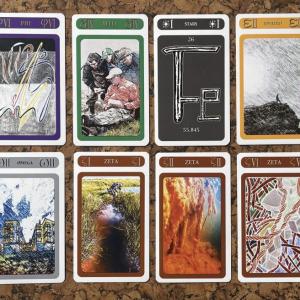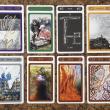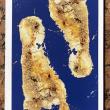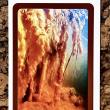The Villard Art Science Expedition deck
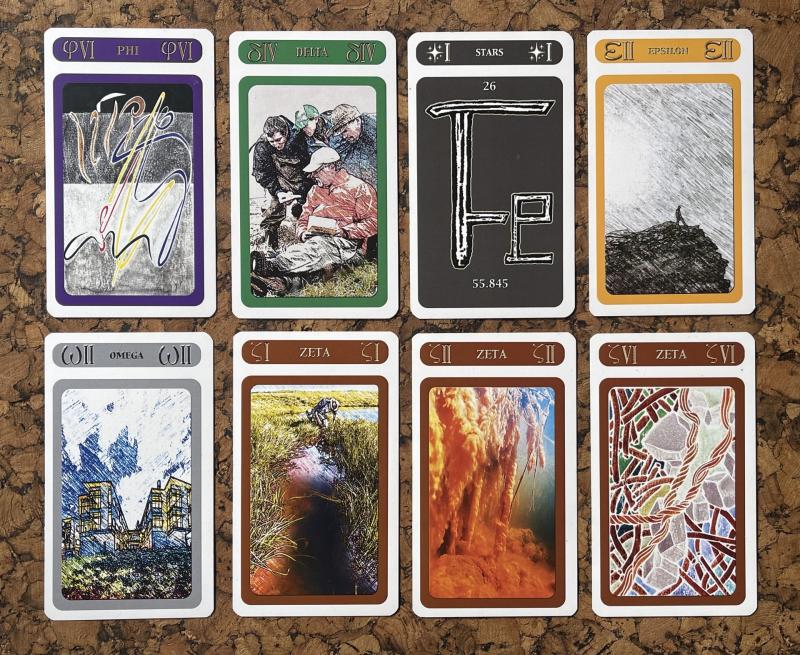 The last card image, bottom right, is a woodcut of an FeOB made previously with Bigelow Lab Senior Scientist, Dr. David Emerson, 10 years ago. The print (part of the collection at MoMA,) was featured in the Villards’ volume “Wetlands” from their “Boothbay Peninsula Environment” series that triggered an invitation to Philippe to be part of the 2019 Arctic project. Courtesy of Kim and Philippe Villard
The last card image, bottom right, is a woodcut of an FeOB made previously with Bigelow Lab Senior Scientist, Dr. David Emerson, 10 years ago. The print (part of the collection at MoMA,) was featured in the Villards’ volume “Wetlands” from their “Boothbay Peninsula Environment” series that triggered an invitation to Philippe to be part of the 2019 Arctic project. Courtesy of Kim and Philippe Villard
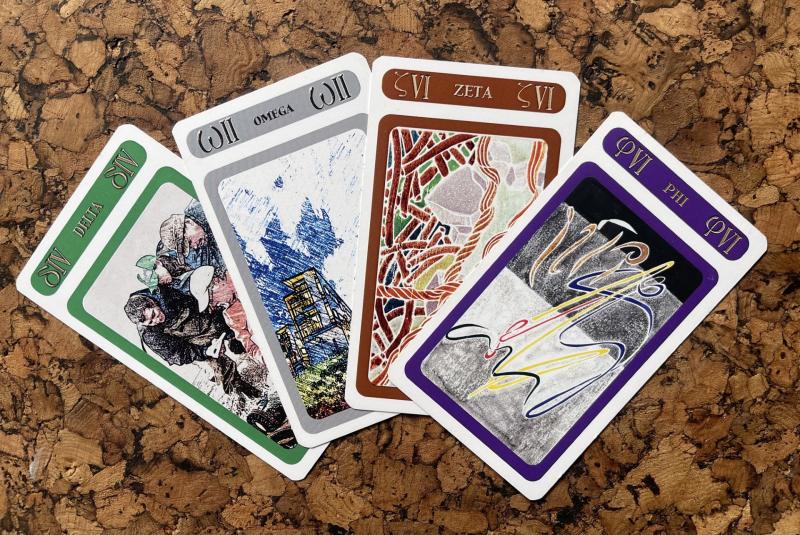 The Art Science Expedition Deck. Courtesy of Kim and Philippe Villard
The Art Science Expedition Deck. Courtesy of Kim and Philippe Villard
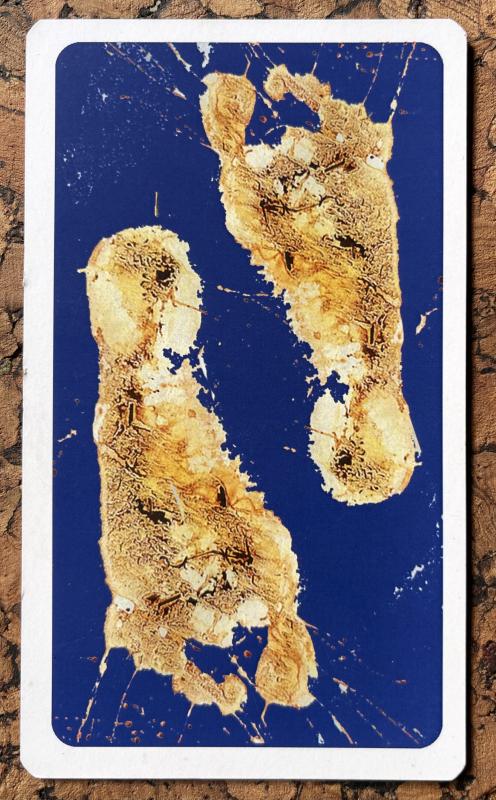 The backs of the deck are Phillippe’s footprints. Courtesy of Kim and Philippe Villard
The backs of the deck are Phillippe’s footprints. Courtesy of Kim and Philippe Villard
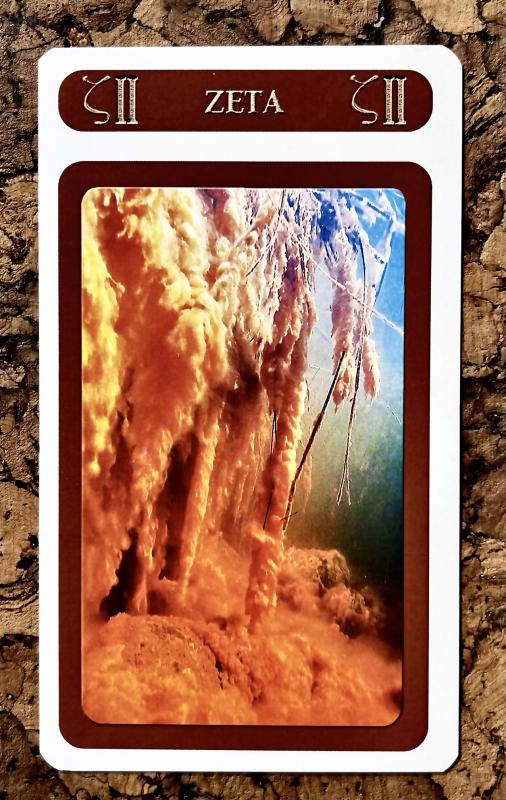 FeOB environment in a melting permafrost pool at a 5 feet depth, one will notice how the bacteria are colonizing Arctic grass draping the edges of the pool. Courtesy of Philippe and Kim Villard
FeOB environment in a melting permafrost pool at a 5 feet depth, one will notice how the bacteria are colonizing Arctic grass draping the edges of the pool. Courtesy of Philippe and Kim Villard
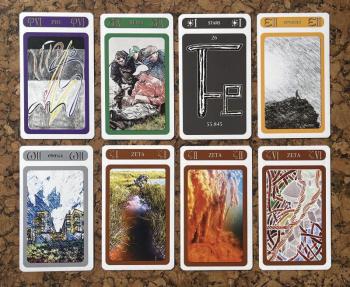 The last card image, bottom right, is a woodcut of an FeOB made previously with Bigelow Lab Senior Scientist, Dr. David Emerson, 10 years ago. The print (part of the collection at MoMA,) was featured in the Villards’ volume “Wetlands” from their “Boothbay Peninsula Environment” series that triggered an invitation to Philippe to be part of the 2019 Arctic project. Courtesy of Kim and Philippe Villard
The last card image, bottom right, is a woodcut of an FeOB made previously with Bigelow Lab Senior Scientist, Dr. David Emerson, 10 years ago. The print (part of the collection at MoMA,) was featured in the Villards’ volume “Wetlands” from their “Boothbay Peninsula Environment” series that triggered an invitation to Philippe to be part of the 2019 Arctic project. Courtesy of Kim and Philippe Villard
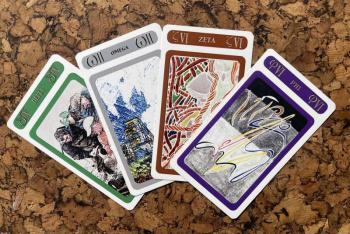 The Art Science Expedition Deck. Courtesy of Kim and Philippe Villard
The Art Science Expedition Deck. Courtesy of Kim and Philippe Villard
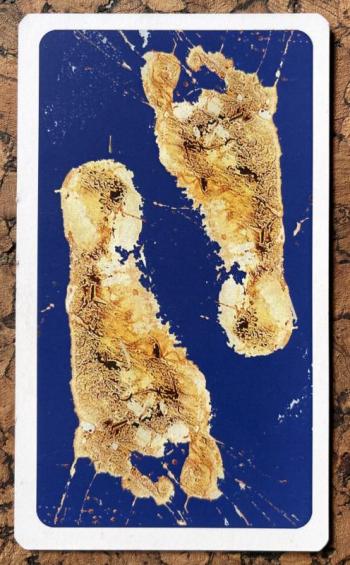 The backs of the deck are Phillippe’s footprints. Courtesy of Kim and Philippe Villard
The backs of the deck are Phillippe’s footprints. Courtesy of Kim and Philippe Villard
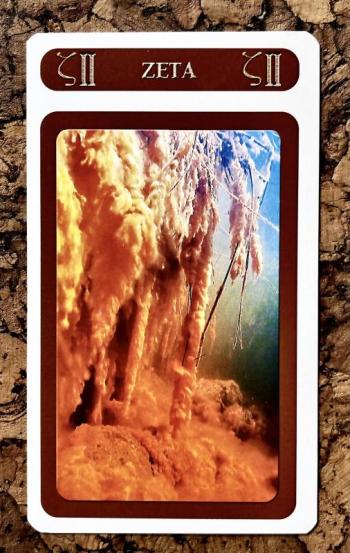 FeOB environment in a melting permafrost pool at a 5 feet depth, one will notice how the bacteria are colonizing Arctic grass draping the edges of the pool. Courtesy of Philippe and Kim Villard
FeOB environment in a melting permafrost pool at a 5 feet depth, one will notice how the bacteria are colonizing Arctic grass draping the edges of the pool. Courtesy of Philippe and Kim Villard
Hey Boomers! Remember flashcards? Those over-sized playing cards used to help memorize multiplication tables, addition and subtraction were used in our house growing up – in my case particularly for math. (Insert shudder here.) Keep such learning cards in mind as you read on about what’s new at Villard Studios.
Adding an educational element to their art is not new for Kim and Philippe Villard. Their names instantly bring the American Whiteline Color Woodblock printing to mind, right? Philippe would draw, and then carve the drawing into the woodblock. Kim painted them with watercolor, and voilá! Each completed woodblock print would simultaneously charm and draw you into images of nature of the Earth, sky and sea, of home and garden ... In 2003 they placed their expertise into a 17-year project of 100 color wood block images reflecting the region’s natural history, titled “The Boothbay Peninsula Environment Presented in White-Line Color Woodblock Prints,” each focusing on a different aspect of the region’s flora and ecology. The volumes were titled Tide Pools, Mycologic, Shellfish, Wildflowers, Sea Visitors and Inhabitants, Wetlands, Insects and Berries, Trees, Birds, Marine Mammals and Sea Birds, Land Mammals, and People and Fish. One complete set is at the MoMA, New York City.
I caught up with them at their 12th century hamlet in the Cork Oak Forest. A forest covering 5 million acres also in Spain, Portugal, Italy, Tunisia, Algeria, Morocco. And, yes, Kim and Philippe are fully invested in the preservation of this forest, through their acreage within it – but that is another story. Those of you who attended one of the monthly soirees at Villard Studios last summer learned about that labor of love.
This summer they will present their latest project: the Art/Science Expedition Deck consisting of 80 cards, the size of large tarot cards or a large smartphone, based on the environment of the Alaskan Arctic, and Bigelow’s 2019 scientific exploration of that region. Philippe was invited to be part of that group of scientists studying iron-oxidizing bacteria at Toolik Field Station on the North Slope of Alaska. They conducted the research to understand, as Philippe wrote on the Villard Studios website, the “interaction of rustic bacteria that could help fight global warming.”
The cards illustrate the expedition and, as Philippe said, “provide a broader spectrum to the investigation of iron in the Arctic – with a grant from the National Science Foundation.”
He said some of the photos were enhanced with pencil drawings and woodblock prints that include a close-up of the environment of iron-oxidizing bacteria (FeOB), including an underwater shot in a pool of melting permafrost. For that 2019 expedition, Philippe had been gifted with an underwater camera. Thanks to that camera, he captured what was a super rare event: a deep gulch environment where the iron-oxidizing bacteria thrive. Last summer, when a Bigelow team went back to the location, that particular environment was gone. Philppe said the discovery was named “Gallionella Gulch” by geomicrobiologist and Bigelow Senior Research Scientist David Emerson, and stars in the team’s work.
A trough, 1 meter-50 deep and 8 meters long, was accessed in the marshy tundra in which, said Philppe, “an environment bloomed over 10 days. It went from nothing to a microbial forest that looked like cities built by micro-organisms. It was incredible!”
That scene he describes is one of the cards in this learning deck. There are 10 suits including each member of the team on the expedition, plus two suits representing the chemical elements; another is of the institutions floating the project under that grant from the National Science Foundation. These card images are photos, film shots from the Arctic, pencil drawings, and seven woodcuts that represent the senses, plus intuition; and some of the iron-oxidizing bacteria – including images from the growth in the trough.
The image on the back of the cards are Philippe’s footprints after he stood barefoot in Arctic iron mud and then onto art paper on location. Some of the card images are printed from powders harvested in the Arctic – talk about an organic project, right?
Cool fact: Philippe said Dr. Emerson, an iron specialist, confirmed that the medium used by neolithic hunter-gathers in rock art and cave paintings were made by heating aquatic microbial iron to differing temperatures to create multiple colors. Philippe noted the oxide colors are the same organism he and Kim use today for their block prints.
Some of the cards have only text, say about the background of a particular scientist, which must then be matched with the image card of that scientist or institution. Explained Kim, “This is to quiz the ‘card holders’ power of observation and participate in the realm of discovery. It’s not about winning or losing, but, as Philippe said, ‘a fun way to see how science collaborates and builds off the work of many.”
“Part of our research has been complex, but we are trying to simplify it. Creating a deck of cards will allow people to go on an expedition into the science through 80 pieces of art,” Kim said. “Instead of creating a book, we created this deck, which can be used in different ways. There are also graphs that have been selected and rendered based on pure science. Basically, the cards are a method of communication about what’s going on with the melting permafrost and what we need to start talking about in a layperson’s terms and to look at things with different perspectives.”
Originally, their proposal was to create a series of woodblock prints that would include scientific graphs, in a coffee table book that would be used to create a traveling show going to different universities. But then COVID came to town. The world and the public shows idea went out the window.
“We thought, we can’t do a public show now – what good is another coffee table book when you can’t have a show?” said Kim. “So we thought maybe we should have something people could homeschool with. Not bound, less expensive, and be accessible to a broader spectrum of people?”
They will have 10-15 or so decks with them this summer at their Boothbay Harbor gallery, but not for sale as yet.
I cannot wait to see the deck and you will feel that way too after you see the images Kim and Philippe sent to accompany this column.
Villard Studios is at 57 Campbell St. in Boothbay Harbor. Find out more about them at www.villardstudios.com

